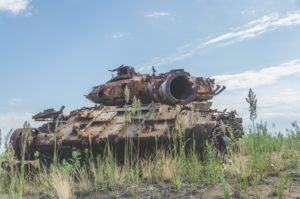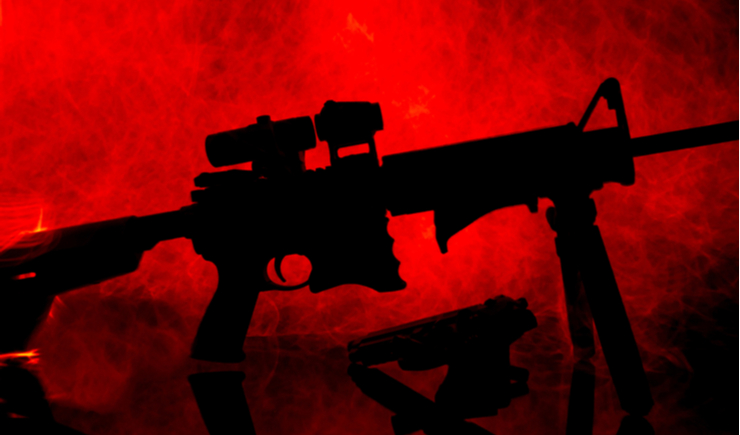
Originally posted on July 20th, 2018.
In Syria, hard lessons are being learned about some of the world’s most powerful tanks, including the Russian T-90A and the German Leopard 2A4 (used by Turkish ground forces). The T-90A and Leopard 2A4 are both equipped with advanced defense systems like Active Protection Systems (APS) and Explosive Reactive Armor (ERA). Given their technological advantages, why are they being destroyed so regularly on the Syrian battlefield?
The answer is that even with APSs and additional armor, these tanks are susceptible to attacks from the side, beneath, and from above. They are also vulnerable to rockets with tandem warheads, kinetic weapons, mines, IEDs, aerial assaults, and even snipers. Snipers often aim for exposed sensors, making the APS useless.
Rebels in the Middle East have become experts in the field of anti-tank tactics. With years of combat experience against these systems, rebels have learned how to ambush and destroy them using a multitude of methods. The losses in Syria have shown that any tank is vulnerable to the proliferation and continued development of long-range ATGM’s. Read more from Sebastien Roblin of The National Interest on the hard lessons of modern tank warfare being learned in the Middle East today.
The interconnected conflicts raging across the Middle East today have amounted to a dreadful human catastrophe with spiraling global consequence. One of their lesser effects has been to deflate the reputations of Western main battle tanks mistakenly thought to be night-invulnerable in the popular imagination.
Iraqi M1 Abrams tanks not only failed to prevent the capture of Mosul in 2014, but they were captured and turned against their owners. In Yemen, numerous Saudi M1s were knocked out by Houthi rebels. Turkey, which had lost a number of M60 Pattons and upgrade M60T Sabra tanks to Kurdish and ISIS fighters eventually deployed its fearsome German-built Leopard 2A4 tanks. ISIS destroyed eight to ten in a matter of days.
While these tanks could have benefited from specific defensive upgrades in some cases, the real lesson to be drawn was less about technical deficiencies and more about crew training, competent morale, and sound tactical employment matter more even than “invulnerable” armor. After all, even the most heavily armored main battle tanks are significantly less well protected from hits to the side, rear or top armor—and rebels with years of combat experience have learned how to ambush imprudently deployed main battle tanks, particularly using long-range anti-tank missiles from miles away.
One exception to the general tarnishing of reputations has been Russia’s T-90A tank, 550 of which serve as Russia’s top main battle tank until the T-14 Armatas fully enters service. The T-90 was conceived in the 1990s as a modernized mash-up the hull of the earlier mass-production optimized T-72, and the turret from the higher-quality (but operationally unsuccessful) T-80. Retaining a low profile and a three-man crew, (the tank’s 2A46M auto-loading cannon takes the place of a human loader), the fifty-ton T-90A is significantly lighter than the seventy-ton-ish M1A2 and Leopard 2.
When Moscow intervened in Syria in 2015 on behalf the beleaguered regime of Bashar al-Assad, it also transferred around thirty T-90As to the Syrian Arab Army, as well as upgraded T-62Ms and T-72s. The Syrian military could desperately use this armored infusion, as it had lost over two thousand armored vehicles in the preceding years—especially after Syrian rebels began receiving American TOW-2A missiles in 2014. The T-90s were spread out between the 4th Armored Division, the Desert Hawks Brigade (composed of retired SAA veterans led by pro-Assad warlords) and Tiger Force, an elite battalion-sized SAA unit specialized in offensive operations. […]
According to Janovský, of the thirty transferred to the Syrian Arab Army, he is aware of five or six T-90As being knocked out in in 2016 and 2017, mostly by wire-guided TOW-2A missiles. (Some of the knocked out tanks, to clarify, may be recoverable with heavy repairs.) Another four may have been hit, but their status after the attack as not possible to determine. Of course, there may be additional losses that were not documented, and there are cases where the type of tank involved could not be visually confirmed. […]
“In my opinion, the major issue with T-90 (and most other modern tanks) is a complete lack of hard-kill Active Protection System [one that shoots missiles down], ideally with 360 degrees coverage, but 270 degrees should be minimum. This not only means that it is vulnerable to being disabled by cheap rocket propelled grenades in urban combat but also from Anti-Tank Guided Missiles fired from unexpected angle. When you consider the range of current ATGMs [typically two to five miles], it will be fairly regular occurrence that you get a side shot opportunity against attacking enemy tank from positions across from the of attacked location.”
Read the full story here.



